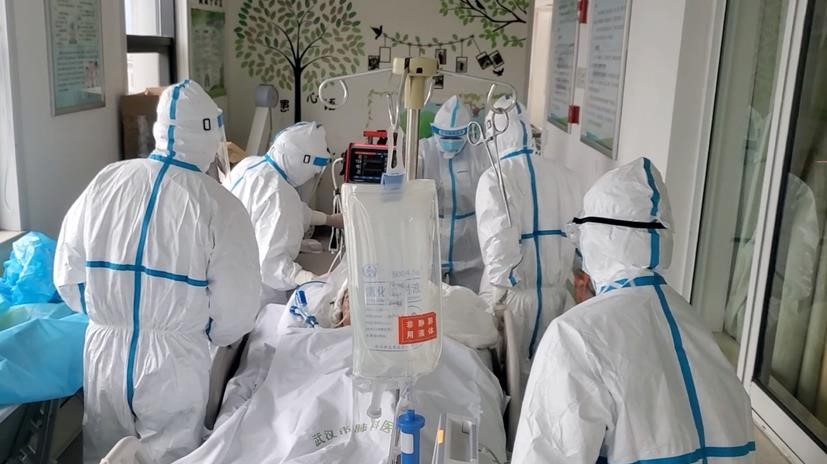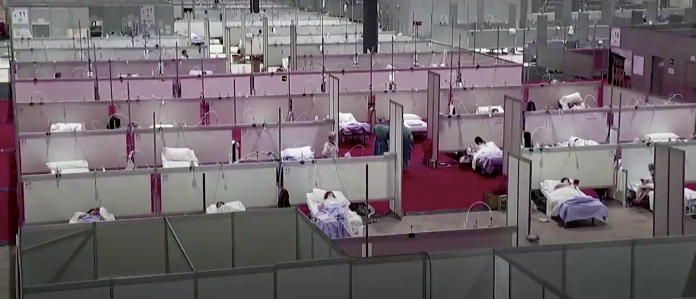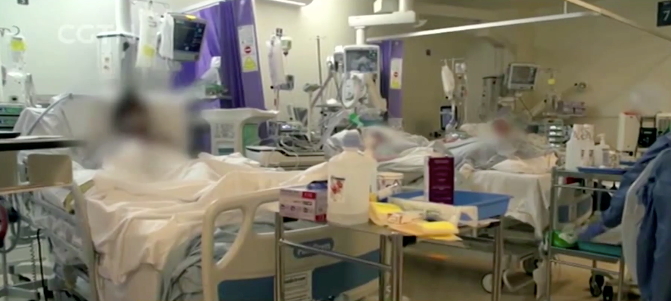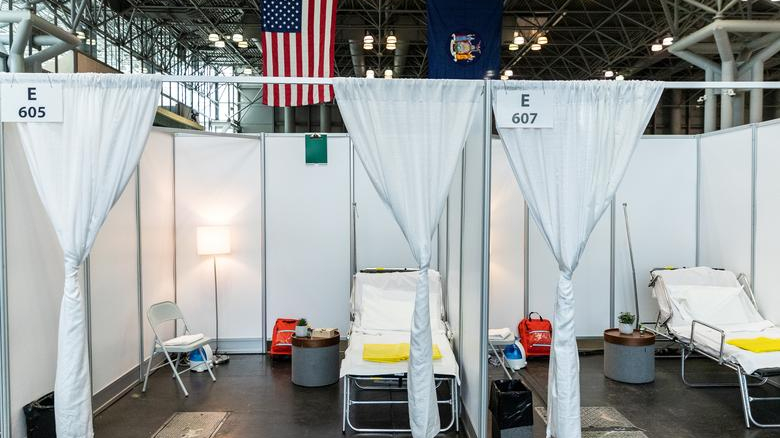Heart beating, oxygen pumping, while the needle draws a zigzag electrocardiogram on a pink grid paper, this may have been the last moment of the patient's life.
Dr. Li Zhouli, a former chief physician at 309th Hospital of People's Liberation Army of China, still vividly remembers how they snatched the patient's life back from the Grim Reaper on a day in 2010.
He told CGTN: "We have three doctors working around the patient, the resident doctor took charge of the basic work, the attending doctor did the treatment, and the director myself would decide on specific treatment plans."
"We've spent three days and three nights... this critical-condition patient with survival rate less than 50 percent, and obvious failures seen in respiratory system, digestive system and liver function, was saved at last."

Doctors transfer a COVID-19 patient to disinfected transitional wards in a hospital in Wuhan, central China, April 21, 2020. /CGTN
Doctors transfer a COVID-19 patient to disinfected transitional wards in a hospital in Wuhan, central China, April 21, 2020. /CGTN
Moving forward to an early April day in 2020, a lady lay on a bed inside an ICU ward belonging to Mount Sinai Brooklyn Hospital; she was one of the early and particularly tough cases. As described in a story published on Intelligence, a New York local magazine, the doctors there said they were especially aggressive and have put in much effort in trying to save her.
Incipiently, the nurses weren't quite experienced to do certain daily care routines, but once they got them done, the patient was initially improving. Then she got worse and worse in the following few days, and eventually she was very likely to die in the next 24 hours, with only 53 years old.
According to Johns Hopkins University, the U.S. has reported more than 1.2 million confirmed coronavirus cases as of Tuesday, with the death toll mounting to 70,646. Within April, the death rate raised from 1.78 percent on April 1 to 5.72 percent on April 26, a multiplication of 2.2.

Medical staff members prepare for a day of COVID-19 testing at Roseland Community Hospital, the U.S.. Daniel Williams/CGTN
Medical staff members prepare for a day of COVID-19 testing at Roseland Community Hospital, the U.S.. Daniel Williams/CGTN
"Globally, about 3.4 percent of reported COVID-19 cases have died," said WHO Director-General Tedros Adhanom Ghebreyesus at the agency's headquarters in Geneva.
So what has caused the COVID-19 fatality rate in the U.S. to double in just a month? Some clues may lie inside the Intensive Care Unit (ICU).
Shortage of medical resources
"How ICU works," said Dr. Li, who used to lead the ICU of his own department, "we call it 'watching'. You need to keep monitoring a patient's status constantly and tackle every problem popped up little by little."
"Bed-doctor ratio, bed-nurse ratio and doctor-nurse ratio are critical in terms of properly managing an ICU, yet this (the ideal ICU working routing) is impossible during this pandemic," added the former army doctor.

Doctors battling on the front line against COVID-19 are facing an extremely heavy workload, Madrid, Spain, April, 2020. /CGTN
Doctors battling on the front line against COVID-19 are facing an extremely heavy workload, Madrid, Spain, April, 2020. /CGTN
As the doctors are swamped by the number of infected patients. So are the nurses. Dr. Robert Foronjy from University Hospital Brooklyn admitted to National Public Radio, an American media, that ensuring the number of nurses is adequate to take care of the critically ill patients is the most challenging thing. Some nurses are quarantined at home due to the infection, and at least two nurses from his hospital have severe symptoms of coronavirus.
On the other hand, the number of beds, especially ICU beds, is another intuitive reflection of a hospital's admission capacity. Having enough beds means every patient who needs the necessary treatment can be taken care of.
However, according to the Institute for Health Metrics and Evaluation (IHME) at the University of Washington, some states in the U.S. seemed to appear running out of both normal beds and ICU beds one month ago.

President Donald Trump watches as Dr. Anthony Fauci, director of the National Institute of Allergy and Infectious Diseases, speaks about the coronavirus in the James Brady Press Briefing Room of the White House in Washington, DC, U.S., April 22, 2020. /AP
President Donald Trump watches as Dr. Anthony Fauci, director of the National Institute of Allergy and Infectious Diseases, speaks about the coronavirus in the James Brady Press Briefing Room of the White House in Washington, DC, U.S., April 22, 2020. /AP
IHME has estimated that by April 10, New York would have a bed shortage of 875, Tennessee short of 813, Michigan short of 357, and Alabama short of 359, meaning that hospitals in these states have been experiencing a shortage of beds for almost one month.
The same circumstances also apply to ICU beds. The hardest-hit state of New York would lack 148 ICU beds by mid-April, while seven states - including Tennessee, Pennsylvania, Florida, and Louisiana - would experience a shortage of more than 30 ICU beds.
The statistics coincide with what has happened at a hospital in Brooklyn. "We still just don't have the staffing or the space for everyone. We had a 12-bed ICU, we opened up a second 12-bed ICU, and yet we still have 15 to 20 patients in the hospital that we need to find a place for," Doctor Adam Brenner, who runs the ICU at Mount Sinai Brooklyn, told local media.
"A lot of the deaths are of the patients that don't make it to the ICU who are sitting on the regular floors and unfortunately can't come here because there are no beds," added Dr. Brenner.

Patients inside an ICU and are waiting to receive treatment in UK, as the country has reported the highest death toll in Europe overtaking Italy, May 5, 2020. /CGTN
Patients inside an ICU and are waiting to receive treatment in UK, as the country has reported the highest death toll in Europe overtaking Italy, May 5, 2020. /CGTN
What has caused the deficit?
Historically, people in the U.S. can always get an ICU bed in a reasonable time frame, since "we have stringent guidelines for who can or cannot stay at the hospital," said Dr. Cynthia Yang, a former resident at Mayo Clinic in Rochester, Minnesota, "and the beds are reserved for the most needed."
"In America, many families are equipped with family doctors," Dr. Yang told CGTN, "this allows people to easily access to medical consultation."
In most cases, given the dedication and professionalism of American family doctors, and their personal connections with local hospitals, if the testing kits were in place, they would have ensured the confirmed patients to be treated accordingly in a timely manner.

The construction of the first temporary hospital, converted from Jacob K. Javits Convention Center has been completed in Manhattan, New York, the U.S., at the end of March 2020. /CGTN
The construction of the first temporary hospital, converted from Jacob K. Javits Convention Center has been completed in Manhattan, New York, the U.S., at the end of March 2020. /CGTN
Yet the April mortality rate of COVID-19 in the U.S. told a contrasting story. "It just happened too fast," said Dr. Yang.
"It also has something to do with early prevention, like wearing masks... Nowadays, America has sped up the testing scale and some states are in general doing better than the others, like California," she said.
Valid methods
In fact, boosting the number of people tested since the moment a country became aware of the new outbreak can be an effective way to reduce possible transmission, said experts at the Robert Koch Institute in Germany.
This finding has also been backed up by Dr. Rothman from the University of Kent in England. He said early detection is not only a very good tactic that can actively prevent the disease from spreading but also a necessary measure to fight a pandemic. Early detection includes testing those with mild symptoms, and it was also the key to Germany's moderately low death rate (four percent).

The media personnel outside St Thomas' Hospital after British Prime Minister Boris Johnson is moved to the ICU in the hospital, London, Britain, April 7, 2020. /Reuters
The media personnel outside St Thomas' Hospital after British Prime Minister Boris Johnson is moved to the ICU in the hospital, London, Britain, April 7, 2020. /Reuters
South Korea is another country that has been benefited from early large-scale detection, which enabled the country to manage the outbreak comparatively well.
Talking about the Wuhan model and how China can contain the virus within the 72-day lockdown of Wuhan, the success was also thanks to early and extensive detection by community workers knocking door to door to take tests if with the kits, or just keeping track of the health status of the residents by taking up their body temperatures.
The myriad of treatment methods is another problem bustling doctors battling at the front-line against COVID-19. "The disease of the lungs is like nothing you've ever seen before" said Dr. Brenner, "there are so many theories about what this is and the best way to manage it, and it just suggests to me that nobody really knows."